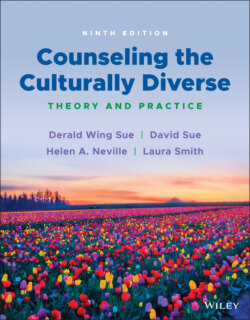Читать книгу Counseling the Culturally Diverse - Laura Smith L. - Страница 112
DILEMMA 1: THE CLASH OF SOCIODEMOGRAPHIC REALITIES
ОглавлениеFor Jaylen and Melanie, a major question confronting them was whether they were perceiving their situations accurately or realistically. Were racism and sexism operating in their respective encounters with others? Were people assuming that Jaylen was not to be trusted, up to no good, or potentially a threat? Was Melanie correct that actions of her male colleagues excluded and rendered her invisible, and that she was seen as less competent and capable because of her gender? Although lived experience told both they perceived the situation accurately, chances are that others would be offended at these suggestions. They would likely deny possessing biases, stereotypes, and acting in ways that were exclusionary. In other words, they would emphasize that they and their organizations do not discriminate on the basis of color, sex, sexual orientation, or creed. The question becomes: Whose reality is the true reality?
Oftentimes, the perceptions held by the dominant group differ significantly from those of marginalized groups in our society. As we have seen earlier, overt displays of racism, sexism and heterosexism appear to have made a comeback and increased in the past few years (Sue, Calle, Mendez, Alsaidi, & Glaeser, 2021), But, many White Americans continue to hold onto the belief that racism is no longer prevalent in society, and not important in the lives of people of color. Further, many men (and women) think that both sexes have achieved nearly equal status in society. Most importantly, most well‐intentioned individuals in our nation and certainly those in power positions do not consider themselves capable of discrimination based on race, gender, or sexual orientation because they are free of bias.
On the other hand, People of Color perceive White Americans to be racially insensitive, to enjoy holding power over others, and to think that they are superior (Sue, Capodilupo, et al., 2007). LGBTQ individuals consider homonegativity and antigay harassment to be a crucial aspect of their everyday existence (Burn et al., 2005; Nadal, 2013). Women contend that sexism is alive and well in social and professional settings. Although research supports the idea that those who are most disempowered are more likely to have an accurate perception of reality, it is the groups in power that have the ability to define reality. Thus, People of Color, women, and LGBTQ individuals are likely to experience their perceptions and interpretations being negated or dismissed. This becomes particularly salient in the therapeutic encounter, which represents an unequal power dynamic. The clash of racial and gender realities represent a major dilemma for Jaylen and Melanie because their realities are likely to be dismissed as inaccurate, or pathologized, and the realities of society or even the therapist is imposed upon them.
